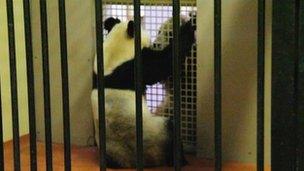Edinburgh Zoo benefits from 'panda effect'
- Published
It is one year since two giant pandas, Tian Tian and Yang Guang, arrived at Edinburgh Zoo from China
Edinburgh Zoo says the arrival of two giant pandas a year ago has boosted its ticket sales by about 50%.
The Royal Zoological Society of Scotland (RZSS), the charity which runs the zoo, says it is on course for 800,000 visitors by the end of the year, up from 536,000 in 2011.
Iain Valentine, director of animals conservation and research, is in no doubt the pandas are driving the rise.
He said: "It's a bigger increase than we expected."
He added: "They're proving to be even more popular than we thought they would be."
Of those visitors, around half a million have queued for a glimpse of the female Tian Tian and the larger male, Yang Guang, whose name means Sunshine.
The Hollywood actor Nicole Kidman and Princess Anne, the Princess Royal, are among those who have peered through the glass of the £250,000 twin enclosures.
Pandas are solitary animals in the wild and the pair are kept apart for most of the year.
Special cake
The iconic animals arrived in Scotland in a blaze of publicity on 4 December 2011, touching down in the snow at Edinburgh Airport in an aircraft emblazoned with the logo of the courier company which had flown them 5,000 miles from Sichuan in China.
They were the first pandas in the UK for 17 years.
A year on, it's a much calmer scene at the zoo where Tian Tian has been celebrating the anniversary with a special cake in the shape of a number one, made of rice and soya and smeared with honey.
Sometimes bamboo just won't do.
It is an apt treat for a panda whose name translates as Sweetie.
The pandas are due to stay in the Scottish capital for at least a decade and Darren McGarry, head of animals at Edinburgh Zoo, says the 12 months have flown by.
"This first year's been really, really exciting. We've learnt a lot about the pandas in the year that they've been here. They've settled in really well."
Visitors seem impressed too.
Matthew Ledder and Megan Munro had travelled to Edinburgh from Leeds.
"I think they're brilliant. I've never seen pandas before," said Mr Ledder.
Ms Munro thought they were "cute".
"The female was sleeping but luckily we got to see the male walking around.
"It's going to do a lot for tourism around here."
Caleb Lai from Edinburgh said he thought Tian Tian looked "lazy" and Yang Guang seemed "bored".
But he said the bears had boosted the Edinburgh economy and raised awareness of the species' plight in the wild, where no more than a few thousand pandas survive.
Million dollars
The Edinburgh pandas are surely among the most observed animals on the planet but star attractions don't come cheap.
The zoo is renting the bears from China for $1m per year.

This year's attempt to encourage the pandas to mate ended in failure
It refuses to reveal the exchange rate, which it says has been fixed for the duration of the agreement, but each twice-yearly instalment is believed to be around £300,000.
The RZSS says figures on takings at the zoo won't be released until the annual accounts are published in the spring.
Critics say the project is about making money not saving a species.
Will Travers, chief executive of the Born Free Foundation, a wildlife charity, says financial benefits to zoos which have rented pandas are "elusive" and conservation benefits "are highly questionable."
Mr Travers says breeding is "virtually non-existent" and "to date, only one giant panda has ever been released back into the wild, and it sadly died a year later."
But the zoo insists its profits benefit the pandas.
Mr Valentine said: "They are generating lots of money for us but of course we are a charity so all that money is just reinvested back into the organisation.
"Without the money we can't do conservation. We don't get money from anybody. So the money that comes into the organisation then does more conservation work not just on pandas but on a range of other species."
Toy pandas
It's not just ticket sales keeping the tills ringing at the zoo: the gift shop is packed with black and white panda merchandise.
In the past year, 70,000 toy pandas have been sold.
The poor penguins, once Edinburgh Zoo's star attraction, have been relegated to the back of the gift shop.
And all this is without any cubs in the panda pen.
In April the zoo announced that attempts to persuade the pandas to mate had failed.
"It's not an easy thing to breed pandas," says Iain Valentine, "they're complicated animals. Very complex biology. Last year was an attempt at it but of course they'd only been here for four months before they were into the breeding season."
But there are some encouraging signs for 2013.
Both pandas are already parents, although not together. Tian Tian has had twin cubs in the past and Yang Guang has also sired offspring.
And the keepers reckon they have made a breakthrough.
Scotland's climate is similar to that in the pandas' home in Sichuan, China, but the animals have never before lived this far north on the globe and it appears that they are not used to the seasonal change in light levels.
To try to even out the long summer evenings and short winter nights, and to ensure that both bears come into season at the right moment -- together -- the zoo is trying a strict lights-out policy.
So from now on it will be early to bed for the pandas with no disturbances.
Edinburgh Zoo hopes it's a recipe for the pitter patter of panda paws.
- Published11 April 2012
- Published5 April 2012
- Published4 December 2011
- Published2 December 2011